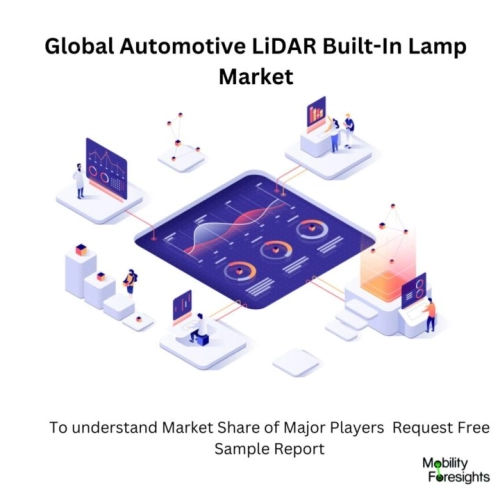
- Get in Touch with Us

Last Updated: Apr 25, 2025 | Study Period: 2023-2030
In recent years, the automotive industry has made great strides, particularly in the area of autonomous driving technologies. LiDAR (Light Detection and Ranging), which employs lasers to detect distances and produce in-depth 3D maps of the environment, is one of the fundamental technologies advancing this field.
Traditionally, LiDAR systems were large and mounted on the outside surfaces of autonomous vehicles, such as the roof. Automotive manufacturers are already looking into the prospect of putting LiDAR sensors directly into the lamps of vehicles, though, thanks to developments in miniaturisation and integration.
A lighting element with built-in LiDAR capabilities is known as an automotive LiDAR built-in bulb. It does two tasks at once by illuminating the road in front of it and utilising the built-in LiDAR sensors to scan the area.
This integration has the following advantages:Aesthetics are improved: By incorporating LiDAR sensors inside the light units, the need for extra external sensor modules or protruding components is eliminated, leading to a sleeker and more integrated vehicle design.
LiDAR sensors give vehicles the ability to identify and precisely gauge the distance to objects in real-time, increasing safety. The field of view can be increased by incorporating them into the lamps, enabling greater detection of obstructions, pedestrians, and other cars, enhancing overall safety.
LiDAR sensors can be shielded from elements like rain, snow, and dirt that could impair their performance and dependability by being incorporated inside lamps. Increased accuracy and consistency are provided by this integration.Automotive LiDAR built-in lamps can be made to work with various vehicle models and producers as they become more commonplace.
This industry-wide standardisation encourages scalability and makes it easy to integrate into different vehicles.Although automobile LiDAR built-in lamps have a lot of potential, they are still in the research and development stage and have not yet gained widespread adoption.
To make transportation systems safer and more effective, continued research and partnerships between technology providers and the automotive industry are most likely to speed up their deployment in autonomous vehicles in the future.

The global automotive LiDAR built-in lamp market accounted for $XX Billion in 2022 and is anticipated to reach $XX Billion by 2030, registering a CAGR of XX% from 2023 to 2030.
SOSLAB revealed that its upcoming 3D solid-state LiDAR 'ML-X' for automotive lights would debut at the CES 2023 in Las Vegas.
The inventors of solid state multi-beam lidar, XenomatiX, have added two new lidar modules to their existing line-up of lidar.
| Sl no | Topic |
| 1 | Market Segmentation |
| 2 | Scope of the report |
| 3 | Abbreviations |
| 4 | Research Methodology |
| 5 | Executive Summary |
| 6 | Introduction |
| 7 | Insights from Industry stakeholders |
| 8 | Cost breakdown of Product by sub-components and average profit margin |
| 9 | Disruptive innovation in the Industry |
| 10 | Technology trends in the Industry |
| 11 | Consumer trends in the industry |
| 12 | Recent Production Milestones |
| 13 | Component Manufacturing in US, EU and China |
| 14 | COVID-19 impact on overall market |
| 15 | COVID-19 impact on Production of components |
| 16 | COVID-19 impact on Point of sale |
| 17 | Market Segmentation, Dynamics and Forecast by Geography, 2023-2030 |
| 18 | Market Segmentation, Dynamics and Forecast by Product Type, 2023-2030 |
| 19 | Market Segmentation, Dynamics and Forecast by Application, 2023-2030 |
| 20 | Market Segmentation, Dynamics and Forecast by End use, 2023-2030 |
| 21 | Product installation rate by OEM, 2023 |
| 22 | Incline/Decline in Average B-2-B selling price in past 5 years |
| 23 | Competition from substitute products |
| 24 | Gross margin and average profitability of suppliers |
| 25 | New product development in past 12 months |
| 26 | M&A in past 12 months |
| 27 | Growth strategy of leading players |
| 28 | Market share of vendors, 2023 |
| 29 | Company Profiles |
| 30 | Unmet needs and opportunity for new suppliers |
| 31 | Conclusion |
| 32 | Appendix |